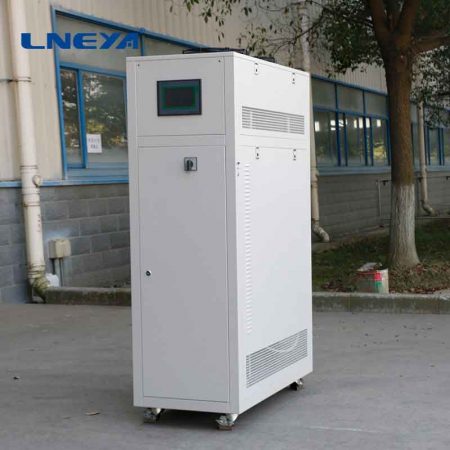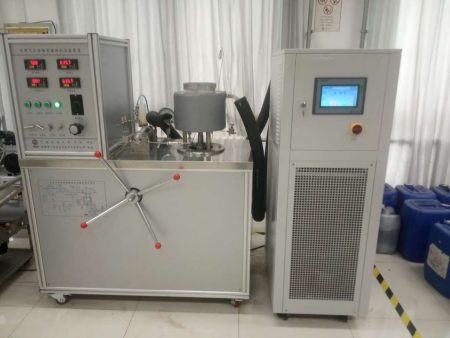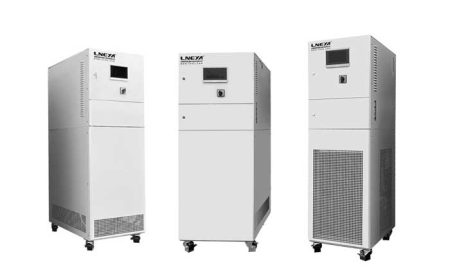Small Chilled Water System
完璧な温度制御ソリューションについては、今すぐお問い合わせください。
In the production process of many industrial sectors, a large amount of waste heat is generated, which needs to be transferred to the natural environment using heat transfer media in a timely manner to ensure the normal operation of the production process. Because natural water has excellent heat transfer properties, is cheap, and is rich in resources, it is used as a heat transfer medium for industrial waste heat. It is called cooling water in industrial production. Industrial cooling water is the largest user of industrial water in various countries. In addition to increasing The physical and chemical properties of cooling water do not change significantly outside the temperature. If appropriate cooling measures are taken to form a recycling system, it is an important way to save industrial water. A small chilled water system is a water supply system in which cooling water is exchanged for hot water, cooled, and recycled. It includes open and closed types and is composed of cooling equipment, water pumps, and pipes.
Cooling principle of small chilled water system:
The operation of the small chilled water system is through three interrelated systems: refrigerant circulation system, water circulation system, and electrical automatic control system.

The principle of small chilled water system
The liquid refrigerant in the evaporator absorbs heat from the water and begins to evaporate. A certain temperature difference is formed between the refrigerant and the water. The liquid refrigerant also completely evaporates into a gaseous state and is sucked and compressed by the compressor (pressure and temperature increase). The gaseous refrigerant absorbs heat through the condenser (air-cooled/water-cooled) and condenses into a liquid. After being throttled by the thermal expansion valve (or capillary tube), it becomes low-temperature and low-pressure refrigerant and enters the evaporator to complete the refrigerant cycle process.

The basic components of small chilled water system:
1. Condenser: During the refrigeration process, the condenser plays the role of outputting heat energy and condensing the refrigerant. After the high-pressure superheated steam discharged from the refrigeration compressor enters the condenser, all the heat absorbed during the working process, including the heat absorbed from the evaporator and refrigeration compressor and in the pipeline, is transferred to the surrounding medium (water or air) is taken away; the high-pressure superheated vapor of the refrigerant condenses back into liquid. (According to different cooling media and cooling methods, condensers can be divided into three categories: water-cooled condensers, air-cooled condensers, and evaporative condensers.)
2. Compressor: The compressor is the core component of the entire refrigeration system and the source of power for refrigerant compression. Its function is to convert the input electrical energy into mechanical energy and compress the refrigerant.
3. Thermal expansion valve: The thermal expansion valve is not only a flow regulating valve in a small chiller refrigeration system, but also a throttle valve in the refrigeration equipment. It is installed between the drying filter and the evaporator in the refrigeration equipment. Its function The temperature sensing bag is wrapped at the outlet of the evaporator. Its main function is to throttle and reduce the pressure of high-pressure and normal-temperature refrigerant liquid when flowing through the thermal expansion valve, and turn it into low-temperature and low-pressure refrigerant wet vapor (mostly liquid, a small part is steam) into the evaporator, and vaporizes in the evaporator. Absorb heat to achieve the purpose of cooling.
4. Evaporator: The evaporator is a heat exchange device that relies on the evaporation (actually boiling) of the refrigerant liquid to absorb the heat of the cooled medium. Its function in the refrigeration system is to absorb heat (or output cooling capacity). In order to ensure that the evaporation process can proceed stably and lastingly, the evaporated gas must be continuously pumped away by a refrigeration compressor to maintain a certain evaporation pressure.
5. Liquid receiver: The liquid receiver is installed after the condenser and is directly connected to the drain pipe of the condenser. The refrigerant liquid of the condenser should flow into the liquid receiver unobstructed, so that the cooling area of the condenser can be fully utilized. On the other hand, when the heat load of the evaporator changes, the demand for refrigerant liquid also changes. At that time, the liquid receiver plays the role of adjusting and storing refrigerant. For small chiller refrigeration equipment systems, liquid receivers are often not installed, but condensers are used to adjust and store refrigerant.
6. Filter dryer: In the refrigeration cycle of a small chiller, moisture and dirt (oil, iron filings, copper filings) must be prevented from entering. The main source of moisture is the newly added refrigerant and the trace moisture contained in the lubricating oil. , or moisture caused by air entering during system maintenance. If the water in the system is not completely removed, when the refrigerant passes through the throttle valve (thermal expansion valve or capillary tube), the water will sometimes solidify into ice due to the drop in pressure and temperature, blocking the passage and affecting the normal operation of the refrigeration device. Therefore, a filter drier must be installed in a small chiller refrigeration system.
7. Refrigerant: Most small industrial chillers used in modern industry use R22 or R12 as the refrigerant. Refrigerant is the flowing working fluid in the refrigeration system. Its main function is to carry heat and absorb and release heat when its state changes.
温度制御システムの設計から製造まで一貫して行います。標準モデルから完全なカスタマイズ製品まで 900 .私たちはカスタマーサービスに特化し、お客様一人ひとりのニーズに合った最適な温度制御システムを提供することに専念しています。
私達は標準外カスタマイズされた解決を提供します。単一の冷却のスリラーおよび冷却及び暖房のコンボの単位は両方利用できます。
Eメール info@lneya.com WeChat ID: +8615251628237 WhatsApp: +86 17851209193

循環式チラー / 冷凍サーキュレーター
(カスタムデザイン)
チラーは様々な産業や研究所で広く使用することができ、カスタマイズされた設計をサポートしています。
| 温度範囲 | -25°C ~ +30°Cシリーズ | -45°C ~ +30°Cシリーズ | -60°C ~ -20°Cシリーズ | -80°C ~ -20°Cシリーズ | -120°C ~ -70°Cシリーズ | ||||
| 冷却能力 | 0.8 ~ 30kW | 0.75 ~ 12kW | 0.4 ~ 6kW | 0.2 ~ 6kW | 0.3 ~ 5kW | ||||
| 注: -150℃の~ +350℃からの温度較差および冷却容量はカスタマイズすることができる | |||||||||
 ウォーター・チラー/小型チラー
ウォーター・チラー/小型チラー
(カスタムデザイン)
チラーは様々な産業や研究所で広く使用することができ、カスタマイズされた設計をサポートしています。
| 温度範囲 | -18°C ~ +30°C | +5°C ~ +35°Cシリーズ | |||||||
| 冷却能力 | 0.35 ~ 0.9kW | 1.8~50kW | |||||||
| 注: -150℃の~ +350℃からの温度較差および冷却容量はカスタマイズすることができる | |||||||||

低温チラー
(カスタムデザイン)
当社は、-150℃の温度制御範囲を持つ低温冷凍機の生産を専門としており、さまざまな業界の冷凍ニーズを満たすことができます。
| 温度範囲 | -25°C ~ -5°Cシリーズ | -45°C ~ -10°Cシリーズ | -60°C ~ -10°Cシリーズ | -80°C ~ -30°Cシリーズ | -110°C ~ -50°Cシリーズ | -150℃〜-110℃シリーズ | |||
| 冷却能力 | 12~360kW | 6~180kW | 6~180kW | 4〜180kW | 2~120kW | 2.5 ~ 11kW | |||
| 注: -150℃の~ +350℃からの温度較差および冷却容量はカスタマイズすることができる | |||||||||

高温チラー
(カスタムデザイン)
チラーは様々な産業や研究所で広く使用することができ、カスタマイズされた設計をサポートしています。
| 温度範囲 | +5°C ~ +40°C | -25°C ~ +40°C | -45°C ~ +40°C | -80°C ~ +80°C | -100°C ~ +80°C | ||||
| 冷却能力 | 6〜40kW | 2~15kW | 1~8kW | 0.6 ~ 3kW | 1.5~3kW | ||||
| 注: -150℃の~ +350℃からの温度較差および冷却容量はカスタマイズすることができる | |||||||||

冷暖房用チラー
(カスタムデザイン)
温度制御範囲:-120°C~+350°C
さまざまな企業で広く利用された冷却および暖房のサーモスタット。
| 温度範囲 | -10 ~ +150℃シリーズ | -25 ~ +200℃シリーズ | -25 ~ +300℃シリーズ | -45 ~ +250°C シリーズ | -45 ~ +300℃シリーズ | -60 ~ +250°C シリーズ | -60 ~ +300℃シリーズ | -70 ~ +250°C シリーズ | -80 ~ +250°C シリーズ | -90 ~ +250°C シリーズ | -100 ~ +100℃シリーズ | ||
| 冷却能力 | 1.5 ~ 15kW | 1~200kW | 1~200kW | 0.45~200kW | 0.9 ~ 25kW | 0.25 ~ 60kW | 0.75 ~ 25kW | 0.4 ~ 15kW | 0.3 ~ 80kW | 0.2 ~ 80kW | 0.45 ~ 80kW | ||
| 注: -150℃の~ +350℃からの温度較差および冷却容量はカスタマイズすることができる | |||||||||||||

循環式ヒーター・チラー
(カスタムデザイン)
温度制御範囲:-45℃~+250
| 温度範囲 | -25°C ~ +200°Cシリーズ | -45°C ~ +250°C シリーズ | |||||||
| 冷却能力 | 1 ~ 15kW | 0.25 ~ 15kW | |||||||
| 注: -150℃の~ +350℃からの温度較差および冷却容量はカスタマイズすることができる | |||||||||
 LNEYA
LNEYA
 简体中文
简体中文


















































































